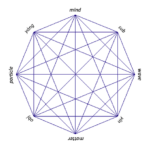IRA is here!
Idealogical Reference Architecture (IRA): an epistemological interpretation of quantum mechanics has been published in pre-print. Abstract below. DOI link here.
Here we expand upon some of the ideas we have proposed around metaphysics in previous works (Valdez 2019, 2022a, 2022b) and build on some of the latest scholarly research as it relates specifically to the problem of mind-body interaction as it can be understood through the mathematics and theoretical underpinnings of Quantum Mechanics (Manousakis 2006; Blaha 2009; Pradhan 2012; Stapp 2001, 2009, 2011).
From an interpretive perspective we follow the von Neumann-Wigner line (von Neumann 1932; Wigner 1967; Stapp 2001) which posits that wavefunction collapse has at least some intellectual, mental corollary. We then follow the latest developments in black hole thermodynamics which have established a mathematical link between the entropy inside a black hole and the information stored on its surface area, i.e. the so-called holographic principle (Susskind 1995, 2005), providing at least circumstantial evidence for the integral role of information theory, and computer science more generally as the science of studying information systems, as it relates to some of the most intractable problems in physics and philosophy – namely the mind-matter boundary problem which is the subject of this paper.
We then proceed to construct, using wave mechanics and quantum measurement theoretical principles (epistemic principles), a theoretical metaphysical engine – a metaphysical Turing Machine – which describes the process by which, again using wave mechanics, an idea becomes reality. We adopt a behavioralist approach to this solution following Eichberger (Eichberger 2018), who builds on Subjective Expected Utility theory (Savage 1954) which underpins most of decision theory in Economics and Statistics, to construct precise mathematical (wave mechanics) and geometrical (Hilbert Space) formulations for both the state of mind, and the state of the world. We construct a unique bridge between the two with IRA.
The study distinguishes itself from other studies in both philosophy and theoretical physics along the same vein by not only by establishing a specific, rigorous mathematical formulation of the model itself, but also by contextualizing the work in both the Western philosophical tradition (Plato, Aristotle, Descartes, Kant, and Schopenhauer specifically), the Eastern philosophical tradition (I Ching, Samkhya and Yoga specifically), as well as theoretical computer science (Turing Machines, Software Engineering and Information Processing systems).
In this capacity we hope that IRA can serve as a framework for comparison (reference architecture) in philosophical circles to remove uncertainty regarding basic principles and their fundamental relations in the same vein as the Turing Machine more or less, as well as provide for a more holistic approach to understanding the interaction between the mind and matter more generally that can be used as a sort of heuristic model in cognitive science and psychological circles. Further areas of study are discussed in the summary and concluding remarks section.









Leave a Reply
Want to join the discussion?Feel free to contribute!